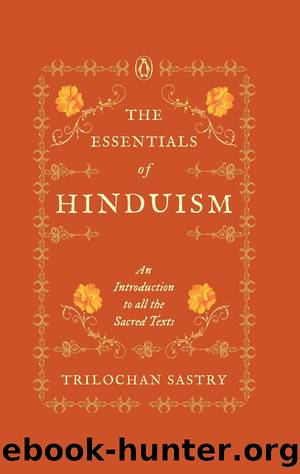The Essentials of Hinduism by Trilochan Sastry

Author:Trilochan Sastry
Language: eng
Format: mobi, epub, azw3
ISBN: 9789354927904
Publisher: Penguin Group
Published: 2022-10-03T00:00:00+00:00
7
PURANAS
The word âpuranaâ literally means âoldâ. Although there are references to the Puranas in the Vedas, some are considered to have been composed as late as the medieval period. Thus, these texts span millennia. However, most of the Puranas are ancient and were composed after the Vedas. The Puranas and the two epics, Ramayana and Mahabharata are part of popular Hinduism. There are eighteen major Puranas or Mahapuranas, namely Brahma, Padma, Vishnu, Siva, Bhagavata, Narada, Markandeya, Agni, Bhavishya, Brahmavaivarta, Linga, Varaha, Skanda, Vamana, Kurma, Matsya, Garuda and Brahmanda. In addition, there are eighteen minor or Upapuranas. It is estimated that together they have over 400,000 verses in Sanskrit. By contrast, the Bhagavad Gita has only 700 verses.
The Puranas discuss cosmology and have stories about the creation of the universe, gods, sages, kings, heroes as well as ordinary people. There are stories with a moral and ethical meaning as well as philosophy. They are intended to convey the essence of religion in a simple way.
According to Puranic lore, Brahma is said to be the Creator of the Universe, Vishnu the Sustainer or Preserver and Siva the One who finally dissolves the Universe. According to the Puranas, the world as we see it will dissolve, and later there will be yet another creation. This cycle of creation and dissolution of the universe continues forever. Brahma, Vishnu and Siva emerged from Brahman, the transcendental, formless, eternal Truth mentioned in the Upanishads. However, there are many versions of this in different Puranas.
The Vaishnava Puranas about Vishnu and His Incarnations are well-known across India. In Puranic lore, Siva appears as Dakshinamurthi as well as a teacher to great sages, although he does not take birth in human form. Some of the Puranas are about Brahma, the Creator who has no human incarnation. In addition to these three gods, there are references to many other gods and goddesses in the Puranas.
The concept of the descent of Godâs incarnation on earth as an avatar in the form of a human being is developed in the Puranas. The well-known idea of the âDasavatarasâ or ten avatars is found in several Puranas, although there are slight variations among them. According to one text, this list includes Matsya (fish), Kurma (tortoise), Varaha (boar), Narasimha (half-man, half-lion), Vamana, Parasurama, Rama, Krishna, Buddha and the yet-to-come Kalki. In some texts, Buddha is substituted by Balarama whereas in some others, Parasurama is replaced by Balarama. However, the Bhagavata Purana is clear about one factâthat Krishna is not an avatar but God Himself and the source from whom all other avatars emerged. It goes on to list twenty-four avatars, many of whom are regarded as partial manifestations. Some of them include Veda Vyasa, Kapila, Nara-Narayana (the twin manifestation of God and His close human friend) who exist for the welfare of the world and Dattatreya who combines the attributes of Brahma, Vishnu and Siva.
It is Vishnu who takes human birth as an avatar while Brahma and Siva do not.* Siva, however, manifests himself occasionally through special human beings.
Download
The Essentials of Hinduism by Trilochan Sastry.epub
The Essentials of Hinduism by Trilochan Sastry.azw3
This site does not store any files on its server. We only index and link to content provided by other sites. Please contact the content providers to delete copyright contents if any and email us, we'll remove relevant links or contents immediately.
Fingersmith by Sarah Waters(2490)
Kundalini by Gopi Krishna(2138)
Wheels of Life by Anodea Judith(2099)
Indian Mythology by Devdutt Pattanaik(1904)
The Bhagavad Gita by Bibek Debroy(1902)
The Yoga of Jesus: Understanding the Hidden Teachings of the Gospels by Paramahansa Yogananda(1807)
Autobiography of a Yogi (Complete Edition) by Yogananda Paramahansa(1778)
The Man from the Egg by Sudha Murty(1751)
The Book of Secrets: 112 Meditations to Discover the Mystery Within by Osho(1633)
Chakra Mantra Magick by Kadmon Baal(1619)
The Sparsholt Affair by Alan Hollinghurst(1549)
Sparks of Divinity by B. K. S. Iyengar(1497)
Avatar of Night by Tal Brooke(1492)
Gandhi by Ramachandra Guha(1488)
Karma-Yoga and Bhakti-Yoga by Swami Vivekananda(1471)
The Bhagavad Gita (Classics of Indian Spirituality) by Eknath Easwaran(1456)
The Spiritual Teaching of Ramana Maharshi by Ramana Maharshi(1407)
Hinduism: A Very Short Introduction (Very Short Introductions) by Knott Kim(1349)
Skanda Purana (Great Epics of India: Puranas Book 13) by Bibek Debroy & Dipavali Debroy(1346)
